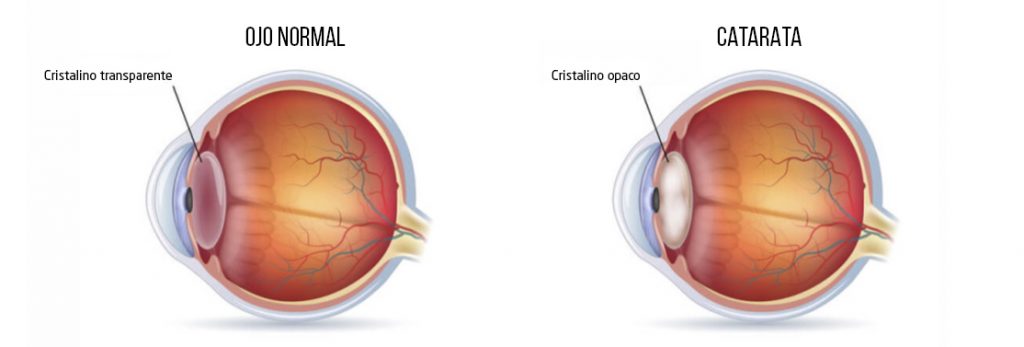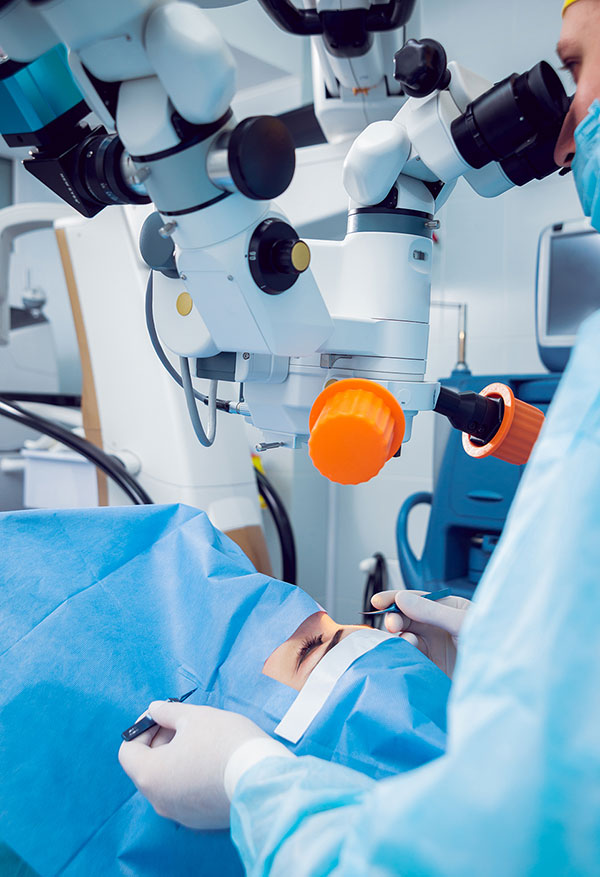WE SOLVE YOUR DOUBTS AND CONCERNS
952 47 83 42
What are cataracts?
The waterfalls are opacities of the crystalline lens, which is a natural lens, that detract from our vision.

Symptoms of cataracts
The main symptoms of cataracts is the loss of visual acuity. It usually develops slowly, and when it occurs in older people, they are sometimes unaware of this decline. This decrease is accompanied by other phenomena such as loss of contrast sensitivity, monocular double vision, altered colour vision, halos, changes in the prescription of glasses, etc., which ultimately lead to a loss of quality of life.
Causes
The causes of cataracts There are many, but the vast majority of them are age-related, appearing mainly after the age of 60, although it is not unusual for them to appear earlier, and some of them are even congenital.
There are genetic diseases that cause cataracts, the ingestion of certain medications, trauma, diabetes, etc... . Myopic people tend to develop cataracts at an earlier age. It is often said that if we lived to be 90 years old we would all have cataracts, as it is a degenerative disease, although this is not strictly true, I have seen patients over 90 years old who see perfectly well.
Cataract diagnosis
The cataract diagnosis is really easy for an ophthalmologist, and is routinely performed in all ophthalmology practices on a daily basis. In a careful examination, we can see that there is a loss of transparency of the crystalline lens, and that there is no other concomitant pathology that could explain the decrease in vision. For this purpose, an OCT examination is very important, which precisely studies the macula, in order to rule out retinal causes that hinder vision.
Treatment
The cataract treatment is surgery, as there is no other effective treatment. Sometimes it is possible, by changing the prescription of the glasses, to improve vision somewhat, but this improvement is usually temporary.
Well, we have been diagnosed with cataracts, and we have been advised to undergo surgery, which is the only solution.
Do I have to have cataract surgery?
If we want to improve vision and quality of life, yes, but depending on the patient's age and habits, it is sometimes not necessary to operate, because they may have sufficient vision for their expectations, and in any case, if their vision decreases, it will always be possible to have surgery in the future.
When do I have the operation?
The ideal is to have surgery when the cataract begins to limit our quality of life. It is not advisable to delay surgery for many years because the cataract hardens and this makes surgery more difficult. My advice is that once we have assimilated the problem and have decided to have surgery, we should not give it too much thought and do it soon, because the fear and uncertainty generated by the surgery will only disappear when it is performed.
In patients who in addition to the cataract have a large spectacle defect, my advice is to have surgery earlier, because by removing the cataract we can eliminate the spectacle defect, and the surgery will bring a greater improvement in quality of life.
Pre-operative tests
We have decided to have an operation, and we have to do some tests before the cataract surgery.
Some are of a systemic nature, consisting of an electrocardiogram, a chest X-ray and a blood test with coagulation. We must not forget that the cataract surgery is a major surgery, because, although most of them are performed under local anaesthesia, the consequences of the surgery will have a very important repercussion on the patient's quality of life, and we have to go to the operating theatre with the maximum guarantees.
Others are of a local nature, performed on the eye, and are carried out in the consultation room. Of course, these include a complete ophthalmological examination with visual acuity, intraocular pressure, fundus examination, etc.
Of particular importance are the following:
Assessment of the corneal endothelium
Assessment of the corneal endothelium by slit-lamp examination and endothelial microscopy. Important to prevent postoperative corneal oedema.
Corneal topography with aberrometry
To assess the possible suitability of multifocal lenses and for a more complete assessment of toric (astigmatism correcting) lens implantation.
OCT
Macular OCT to assess macular function and rule out other causes of decreased visual acuity that may go unnoticed.
Biometrics
This technique consists of measuring certain parameters of the eye to calculate the power of the lens to be implanted. It is important to apply state-of-the-art formulas to be as precise as possible.
Lens Types
We have already decided to have the operation and now we have to choose the type of lens we want to have implanted.
What types of lenses are there?. Basically, there are monofocal and multifocal lenses, and both can be toric or non-toric. Let's take a brief look at the advantages and disadvantages of each of them.
Monofocal Lenses
They provide good visual quality, but as the name suggests, they focus only at a certain distance, e.g. far away, and to see at other distances you need glasses.
Toric single vision lenses
They are monofocal lenses which also correct astigmatism. They would only be indicated for patients with this condition, as is logical. As a disadvantage compared to single vision lenses, we would say that they are more expensive.
Multifocal lenses, including extended range lenses
They are lenses that focus at different distances, far, intermediate distance for the computer and close for reading. The aim is to get rid of glasses, if not in all situations, then in most of them. To begin with, not everyone is a candidate for them, because in patients with other types of eye problems, such as advanced glaucoma, macular problems, corneal aberrations, etc., they are not suitable for implantation. Likewise, they must be centred in the surgery, and if there is an intraoperative problem, it may not be advisable to place them. In very old people, over 80 years of age, their indication is doubtful because they require an adaptation that is difficult to achieve at this age. They are also more expensive than monofocal lenses. However, in ideal patients, these lenses usually achieve independence from glasses.
Toric multifocal lenses
They are multifocal lenses which also correct astigmatism. They have the same advantages and disadvantages as multifocal lenses. Residual astigmatism must not be greater than 1 dioptre for good visual quality.
There is also the possibility of monovision, which consists of operating on both eyes with monofocal lenses, leaving one of the eyes slightly myopic so that the patient can see something up close. This is a good option for very old people.
Complications of cataract surgery
Cataract surgery is unfortunately not without complications, although the vast majority of patients, more than 95%, improve their visual situation even with the onset of complications.
For the sake of simplicity, complications can be classified into severe and mild.
Serious cataracts pose a threat to vision and sometimes require other interventions or actions, including intraocular infection or endophthalmitis, cataract falling into the vitreous cavity, retinal detachment and corneal decompensation, all of which are very infrequent and can be solved with other surgery or intraocular antibiotic treatment.
The mild ones are frequent and are resolved with medical treatment in a few days and do not pose a threat to vision. Such as moderate corneal oedema, postoperative iridocyclitis, immediate postoperative blood pressure increase, etc.
Patient preparation for cataract surgery
If you are a patient of the Dr. Salvador Nebro Coboswe will have performed the main tests on you in our Clínica Oftalmológica de Fuengirola, Mijas (Málaga). The day of the cataract surgery arrived, we had all the tests, we were informed about the possible problems of the surgery, we chose the lens, and the day arrived.
¿What do I have to do before cataract surgery?. Sometimes anticoagulants have to be withdrawn, sometimes antibiotics are prescribed in the days preceding it. In any case, the surgeon will be the one to explain and prescribe the establishment or suppression of a treatment.
On the day of the surgery, you must fast and take your usual medication with water only, always in consultation with the surgeon. We will be given an intravenous line, and we will be given drops to dilate the pupils.
We are almost there. We're going to the operating theatre.
Where is cataract surgery performed?
The surgery is performed in a safe hospital environment, in modern, fully equipped and secure facilities, we operate in Benalmádena, in the Benalmádena complex. Hospital Vithas Xanit in Benalmádena and in Malaga at the HLA El Angel Hospital.
What type of anaesthesia is usual, will it hurt? Nowadays most cataracts are operated on under topical anaesthesia with sedation. The patient feels that he/she is being operated on, but usually feels no pain, at most discomfort. If they are nervous, they are sedated. In eyes that are presumed to be difficult to operate on beforehand, we can use regional anaesthesia, which is deeper, and in some patients, and exceptionally, general anaesthesia.
What technique will you use?
The majority of cataracts in the western world are operated on by ultrasound. It is a technique that has proven its safety and excellent results.
It is also possible to intervene by femtosecond laser. Does this technique offer fewer complications than ultrasound? The answer is no. The femtosecond laser is no safer than an expert surgeon. It also has the disadvantage of making surgery more expensive. Only in a few surgeries in very complex cases does it have a clear advantage over ultrasound.
Will I get points?
Most of the time it is not necessary to stitch, although sometimes, if the wound is not watertight, it is done for safety. In any case, stitches are not usually an inconvenience to be taken into account.
How long does cataract surgery last?
Surgery usually lasts between 15 and 25 minutes. No two surgeries are the same, and these small differences mean that some take longer than others.
When will I see well?
Some patients have good vision the next day, but it is not uncommon for them to have good vision for 3 to 4 days if there is corneal inflammation.
Care after Cataract Surgery
Do I have to undergo any treatment?
Yes, usually a treatment with antibiotic and anti-inflammatory eye drops is started. For a week, I recommend a protective shield for sleeping.
What can and cannot I do after surgery?
Immediately after surgery, it is advisable to avoid dirty environments, such as gardening or looking after animals. We should not submerge the head, at the beach or swimming pool, because the pressure of the water could cause it to enter the eye. Neither should we make great physical efforts. You can lead a practically normal life. We can go for walks, take a shower, watch TV, etc. If you have any doubts about any activity, do not hesitate to ask.
When is the final discharge from the process and prescription of graduation if necessary?
Normally one month after surgery, when the wound has adequate stability, as this influences the final graduation.
How long do I have to be on sick leave?
It depends, but in normal conditions we can be talking about a period of around two weeks.
Is it possible to have a cataract in an eye that has previously undergone cataract surgery?
Yes, when we perform cataract surgery, we implant the intraocular lens resting on the posterior capsule of the crystalline lens. This is normally left clean during surgery, but it is alive, and cells can grow on its surface, causing it to lose its transparency. This phenomenon is called secondary cataract. It usually appears years after surgery and can be easily solved in the doctor's surgery by opening an aperture in the posterior capsule with the Yag laser. Sometimes, to simplify matters, secondary cataract is explained by saying that "the lens is dirty and needs to be cleaned with the laser".
Do I need to be checked?
Yes, normally the patient is reviewed the day after surgery at our clinic in Fuengirola. I schedule a check-up after two weeks and another one after one month. If conditions make it advisable, sometimes more check-ups can be arranged.
How long do I have to wait between the surgery on one eye and the other?
Although there are ophthalmologists who operate on both eyes at the same time, most of us prefer to operate on different days. Ideally, at least one week should elapse between surgery on one eye and the other.
Cataract and Glaucoma Surgery
Patients suffering from glaucoma and need cataract surgery, depending on their condition, they can undergo cataract surgery alone or combine cataract and glaucoma surgery in the same surgical procedure. Performing them in the same procedure has the disadvantage that we are performing a more aggressive and inflammatory procedure on the eye, and the advantage that in a single procedure we can act on both problems.


Cataract and macular degeneration surgery
Suffering from macular degenerationr is not a contraindication for cataract surgery, it does mean a lower expectation of visual recovery, as part of the vision loss is due to the macular condition, for which surgery will not bring any improvement, although many patients can improve their quality of life.
Special lenses can be used in these patients that produce a magnification over the macula of near objects that helps reading using the remaining healthy part of the macula.
It is known that cataract surgery does not increase the likelihood of developing a cataract. macular degeneration.
If the patient already has dry macular degeneration, surgery does not increase the likelihood of worsening, however, if the macular degeneration is wet it is unclear whether it may increase the likelihood of worsening.

History of the Falls
Why are they called cataracts?Etymologically, cataract means the one that strikes downwards. In ancient times it was thought to be caused by the accumulation between the pupil and the lens of a fluid that fell from the brain, something similar to cataracts in rivers.
We know that surgical treatment of cataracts has existed since at least the 18th century BC, as it is reflected in Hammurabi's code. An awl was used and the cataract was then ablated inside the eye (cataract reclination).
Reclining technique
This technique remained largely unchanged until the Modern Age. As a curiosity, in the novel "The Doctor" by Noah Gordon, a cataract surgery is recreated by means of reclining.
The results were not very good, as is to be expected. The technique did not change until the second half of the 19th century.
Currently the most common technique is extraction by ultrasound, known as phacoemulsification. An even newer technique is the use of femtosecond laser.

